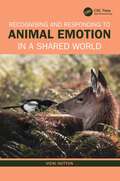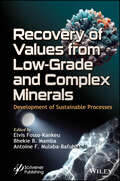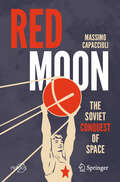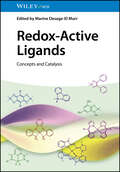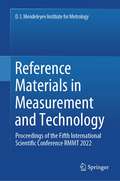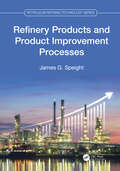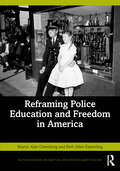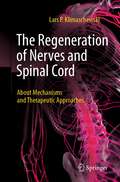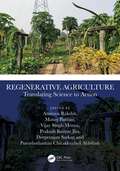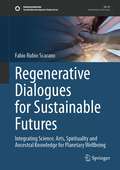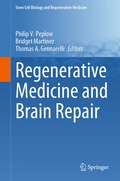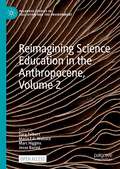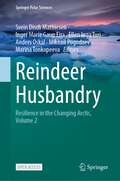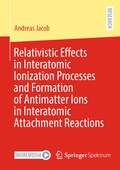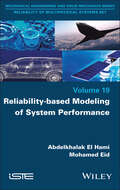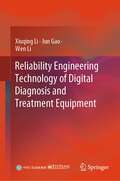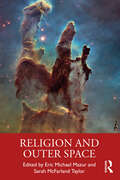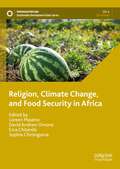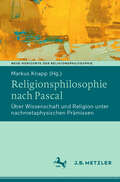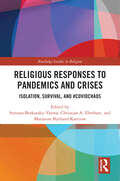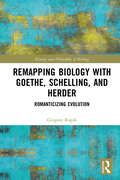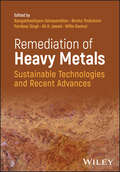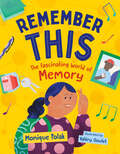- Table View
- List View
Recognising and Responding to Animal Emotion in a Shared World
by Vicki HuttonHow is it that depending on the setting, the same cat can be perceived as a homeless annoyance, a potential research subject or a thinking and feeling family member? The answer is bound up in our perception of non-human animals’ capacity to experience emotions, and this book draws on contemporary evidence-based research, observations, interviews and anecdotal case scenarios to explore the growing knowledge base around animal emotion. Acknowledging that animals can experience feelings directly affects the way that they are perceived and treated in many settings, and the author explores the implications when humans apply – or ignore – this knowledge selectively between species and within species. This information is presented within the unique context of a proposed hierarchy of perceived non-human animals' emotional abilities (often based on human interpretation of the animal’s emotional capacity), with examples of how this manifests at an emotional, spiritual and moral level. Implications for specific groups living with, caring for or working with non-human animals are examined, making the book of particular interest to those working, studying or researching in the veterinary professions; animal ethics, law and welfare; and zoology, biology and animal science. This book will also be fascinating reading for anyone interested in simply learning more about the animals with whom we share this planet. For some readers, it will validate the reciprocal emotional bond they feel for living creatures. For others, it will raise questions about the moral treatment of sentient non-human beings, breaking down the human protective barrier of cognitive dissonance and activating a cycle of change.
Recombinant Glycoproteins: Methods and Protocols (Methods in Molecular Biology #2762)
by Steven B. BradfuteThis detailed volume explores the production and purification of glycoproteins for therapeutic use or basic research, as well as the necessary in-depth understanding of cellular and acellular systems available for these purposes, their advantages and disadvantages, and considerations for choosing the most appropriate system for the desired application. Beginning with chapters on viral-encoded glycoproteins and those found in other pathogens, the book continues by examining the production of mammalian glycoproteins, the analysis of glycoprotein content, cell-free synthesis of glycoproteins and considerations for production and purification of glycoproteins. Written for the highly successful Methods in Molecular Biology series, chapters include introductions to the respective topics, lists of the necessary materials and reagents, step-by-step and readily reproducible laboratory protocols, and tips on troubleshooting and avoiding known pitfalls. Authoritative and practical, Recombinant Glycoproteins: Methods and Protocols provides a wide range of guidelines for studying these vitally important proteins.
Recovery of Values from Low-Grade and Complex Minerals: Development of Sustainable Processes
by Elvis Fosso-Kankeu Bhekie B. Mamba Antoine F. Mulaba-BafubiandiRecovery of Values from Low-Grade and Complex Minerals The book elaborates on various physicochemical properties of minerals and technological developments to improve the recovery of metals while ensuring cost-effectiveness and minimal environmental impact. The mineral industry is undergoing significant cultural, organizational, and technological transformations to address some of the major limitations and challenges related to the environmental and productivity domains. As far as productivity is concerned, the decrease of high-grade ores has been one of the stumbling blocks toward the achievement of maximum recovery of metals while, on the other hand, the complexity of minerals therein makes it difficult to profitably extract metals using only conventional methods. This book presents eight specialized chapters that focus on the exploration of the complexity of minerals that are likely to negatively influence the recovery of values, as well as the development of adequate technologies capable of improving the process of mineral concentration and/or metal recovery from complex minerals in a sustainable manner. It reviews the various physicochemical properties of minerals that are likely to pose a challenge during the attempt to recover values using conventional methods. It also elaborates on the recent technological development that has been considered by researchers to improve the recovery of metals from gangue-dominated minerals while ensuring cost-effectiveness and minimal adverse environmental impact. Audience This book will be of interest to academic researchers from the fields of mineral processing, hydrometallurgy, geochemistry, environment, chemistry, engineering, and professionals including mining plant operators, environmental managers in the industries, government regulatory bodies officers, and environmentalists.
Red Moon: The Soviet Conquest of Space (Springer Praxis Books)
by Massimo CapaccioliThe book is about the “space race”, starting from the earliest steps of astronautics to the Moon landings of Armstrong and Aldrin. The conquest of space began as a by-product of an exquisitely military project, the rapid, and efficient delivery of explosives, conventional and then nuclear, over great distances into enemy territory. It happened at the turn of World War II, first with the V2s, the Wunderwaffen that von Braun had created for his Führer, and, after the surrender of Germany and Japan, with the intercontinental ballistic missiles that the Russians and Americans built to serve as cabs for atomic bombs. Restrained by the fear of nuclear holocaust, the two great powers that had momentarily divided the government of the world turned the risky muscular confrontation into an unusual race to climb the sky: a stage race with a conventional finish line marked by the human landing on the Moon. Under the constant guidance of Sergei Korolev, the mysterious “chief designer”, the Soviets got off to a surprise start and stayed in the lead until almost the end, with the Sputniks, the orbital flights of Gagarin and Tereshkova, the first spacewalk, and the unmanned soft landings on the Moon and Venus, only to be caught up and overtaken by the Americans at the very edge. An adventure that lasted a total of twelve years, marked by brilliant and courageous men, by astute and far-sighted politicians, by patriotism and ambition, and, as always, regulated by luck, which profoundly affected our world and the design of its future.
Redox-Active Ligands: Concepts and Catalysis
by Marine Desage-El MurrRedox-Active Ligands Authoritative resource showcasing a new family of ligands that can lead to better catalysts and promising applications in organic synthesis Redox-Active Ligands gives a comprehensive overview of the unique features of redox-active ligands, describing their structure and synthesis, the characterization of their coordination complexes, and important applications in homogeneous catalysis. The work reflects the diversity of the subject by including ongoing research spanning coordination chemistry, organometallic chemistry, bioinspired catalysis, proton and electron transfer, and the ability of such ligands to interact with early and late transition metals, lanthanides, and actinides. The book is divided into three parts, devoted to introduction and concepts, applications, and case studies. After the introduction on key concepts related to the field, and the different types of ligands and complexes in which ligand-centered redox activity is commonly observed, mechanistic and computational studies are described. The second part focuses on catalytic applications of redox-active complexes, including examples from radical transformations, coordination chemistry and organic synthesis. Finally, case studies of redox-active guanidine ligands, and of lanthanides and actinides are presented. Other specific sample topics covered include: An overview of the electronic features of redox-active ligands, covering their historical perspective and biological backgroundThe versatility and mode of action of redox-active ligands, which sets them apart from more classic and tunable ligands such as phosphines or N-heterocyclic carbenesPreparation and catalytic applications of complexes of stable N-aryl radicals Metal complexes with redox-active ligands in H+/e- transfer transformations By providing up-to-date information on important concepts and applications, Redox-Active Ligands is an essential reading for researchers working in organometallic and coordination chemistry, catalysis, organic synthesis, and (bio)inorganic chemistry, as well as newcomers to the field.
Reference Materials in Measurement and Technology: Proceedings of the Fifth International Scientific Conference RMMT 2022
by Egor P. Sobina Sergey V. Medvedevskikh Olga N. Kremleva Ivan S. Filimonov Elena V. Kulyabina Anna V. Kolobova Andrey V. Bulatov Vladimir I. DobrovolskiyThe book covers in particular state-of-the-art scientific research about product quality control and related health and environmental safety topics, including human, animal and plant safety assurance issues. These conference proceedings provide contemporary information on the general theoretical, metrological and practical issues of the production and application of reference materials.Reference materials play an integral role in physical, chemical and related type of measurements, ensuring their uniformity, comparability and the validity of quantitative analysis as well as, as a result, the objectivity of decisions concerning the elimination of technical barriers in commercial and economic, scientific and technical and other spheres of cooperation. The book is intended for researchers and practitioners in the field of chemistry, metrologists, technical physics, as well as for specialists in analytical laboratories, or working for companies and organizations involved in the production, distribution and use of reference materials.
Refinery Products and Product Improvement Processes (Petroleum Refining Technology Series)
by James G. SpeightThis book focuses on the various refinery products, product improvement processes, and solvent processes that are used in the refining industry and the processes used in product improvement to ensure products meet sales specifications. This accessible book is written for engineers, scientists, students, and academics wanting an update on crude oil processing and insight into the direction of the industry.Key features:• Describes the development of technologies for a variety of feedstocks, including heavy feedstocks utilizing advanced pre-treatment processing and hydrotreating.• Presents the initial refining processes and prepares for the new changes and evolution of the industry, including the role of biomass in the future refinery. • Analyses catalyst deactivation mechanism for developing optimum technologies for processing feedstocks with low reactivity.• Includes an extensive glossary which will be beneficial for non-technical readers.
Reframing Police Education and Freedom in America (Routledge Series on Practical and Evidence-Based Policing)
by Martin Alan Greenberg Beth Allen EasterlingThis book untangles the components of police education and advocates a robust community-based training model with significant civilian oversight. The recommended approach recognizes that the citizenry needs to be included in the provision of basic police education, for it is they who must both support and be served by their police. The police must be role models for society, demonstrating that freedom and rights come with obligations, both to the community as a whole and to individuals in need within that community. Ultimately, the quality of police training and the public’s safety depend not only on the leadership of police executives as well as the quality of educational institutions and police candidates but also on the building of a community’s trust in its police.The issues of police recruitment, education, and retention have greater consequence in an era when protests and other signs of negativity surround law enforcement. Several incidents, including, most notably, George Floyd’s murder by police, have sparked new training initiatives regarding police de-escalation and community engagement. At the same time, the proliferation of gun violence and a contentious political climate have led some officers to refrain from undertaking proactive types of policing. In this context, reform of the police education system is urgent. This book examines police training at all levels of government—local, regional, state, and federal. In addition, citizen participation programs, including the role of the media and programs for furthering law-related education (LRE), are highlighted. The proposed police education model recognizes that ordinary members of the American public need to contribute to the provision of basic police education, for it is they who must both support and be served by their police. The focus is on teaching a "guardian style" of policing at the local level. Police education would combine higher education, necessary practical proficiencies, and intensive field experiences through a gradual level of greater responsibility—likely extending over a 2-plus-year period for trainees with less than a year of previous college credits.This book will be of interest to a wide range of audiences such as law enforcement professionals and trainers, including those in executive development programs in police departments; community leaders, scholars, and policy experts who specialize in policing; concerned citizens; and students of criminal justice, especially those interested in police organization and management, criminal justice policy, and the historical development of police.
The Regeneration of Nerves and Spinal Cord: About Mechanisms and Therapeutic Approaches
by Lars P. KlimaschewskiThis non-fiction book provides information about the latest findings on research and therapy of nerve regeneration with catchy drawings and in understandable words. Why do nerves in the extremities regenerate, but the axons in the spinal cord do not? Can transplanted stem cells or biopolymers restore regeneration? Are bioprostheses able to functionally replace amputated arms or legs? Neuroscientist Lars Klimaschewski answers these questions and reports on exciting findings from anatomy, cell and molecular biology and neurotechnology. Find out, among other things, how a brain-computer interface processes signals from the brain in order to control the arm or leg muscles again via electrodes after a paraplegia.The translation was done with the help of artificial intelligence. A subsequent human revision was done primarily in terms of content.
Regenerative Agriculture: Translating Science to Action
by Amitava Rakshit Manoj Parihar Vijay Singh Meena Prakash Kumar Jha Deepranjan Sarkar Purushothaman Chirakkuzhyil AbhilashThis book aims to focus on the current state of knowledge and scientific advances about the complex and intertwined issues of regenerative farming as a transformative solution for offsetting the disastrous climate effects of burning fossil fuels and impairments of natural resource bases. Regenerative agriculture advocates no-till practices, planting cover crops, integrating livestock and crop production, improving animal welfare practices, improving the social and economic well-being of communities, sequestering carbon, improving soil health, and increasing yields and profit with a positive impact on food access or food safety regardless of farm size.This book examines the innovations that will equip agriculture to cope with the competing challenges of addressing food and nutrition security, improving livelihoods, combatting climate change, and sustainably managing natural resources. The scope of this book extends to agricultural scientists, students, consultants, site owners, industrial stakeholders, regulators, and policymakers.
Regenerative Dialogues for Sustainable Futures: Integrating Science, Arts, Spirituality and Ancestral Knowledge for Planetary Wellbeing (Sustainable Development Goals Series)
by Fabio ScaranoThis book is about sustainability in its broadest sense. It argues that the ongoing science-policy dialogue on sustainable development (as framed by the United Nations’ Sustainable Development Goals) is insufficient to drive the planet to desired sustainable futures. This conversation, followed by transformative action, must be inclusive of other forms of interpretation of reality (arts, spirituality, and ancestral knowledge) and non-modern cosmovisions. This is more a book about dialogues than about the common dualism problem/solution, and such dialogues are approached as an essential trigger of regeneration. The book takes the reader from a historical perspective of the human-nature relationship through to a discussion on sustainable futures as utopias. The optimism conveyed by the book is justified by a plethora of global examples of such regenerative dialogues.
Regenerative Medicine and Brain Repair (Stem Cell Biology and Regenerative Medicine #75)
by Philip V. Peplow Bridget Martinez Thomas A. GennarelliThis book presents the latest knowledge, trends, and advances in cell transplantation and innovations in developing microspheres, 3D biomaterial constructs to enhance transfer, and cell survival to specific regions of the brain. Neurodegenerative diseases and brain injury are increasing. Medications currently only temporarily reduce some of the symptoms but do not cure or delay progression of the disease. Development of effective treatments dramatically improves the independent living and quality of life of patients. Cell transplantation strategies offer an approach to facilitating brain repair, but efficacy is often limited by low in vivo survival rates of cells that are injected in suspension. Transplanting cells that are attached to or encapsulated within a biomaterial construct has the advantage of maintaining cell-cell and cell-material interactions and improving cell survival in vivo. Biomaterials that have been used in preclinical studies to assist with in vivo cell transfer and survival include heparin-chitosan microspheres, poly(lactic-co-glycolic acid) microspheres, RADA 16 microspheres, poly(desaminotyrosyl tyrosine ethyl ester carbonate) microscale scaffolds, carbon nanotubes, collagen-chitosan scaffolds, poly(L-lactic acid) scaffolds, agarose hydrogels, gelatin methacrylate hydrogels, and agarose micro-columns with an extracellular matrix interior. Incorporating growth factors (e.g., glial-derived neurotrophic factor, neurotrophin 3) into the biomaterial constructs increased cell survival and incorporation into the host tissue. International experts in the fields of both experimental and clinical neurological research contribute chapters to this book and discuss the latest achievements in cell transplantation and matrix-assisted cell transfer/survival technologies for diseases such as Alzheimer’s disease, Parkinson’s disease, and brain injuries such as stroke and traumatic brain injury. It is envisaged that research findings in experimental animal models of Alzheimer’s disease, Parkinson’s disease, traumatic brain injury, and stroke promote clinical trials using biomaterial-assisted transfer of cells.
Reimagining Science Education in the Anthropocene, Volume 2 (Palgrave Studies in Education and the Environment)
by Sara Tolbert Maria F. G. Wallace Marc Higgins Jesse BazzulThis volume, a follow up to Reimagining Science Education in the Anthropocene (2021), continues a transdisciplinary conversation around reconceptualizing science education in the era of the Anthropocene. Drawing educators from many walks of life and areas of practice together in a creative work that helps reorient science education toward the problems and peculiarities associated with this contemporary geologic time. This work continues the mission of transforming the ways communities inherit science and technology education: its knowledges, practices, policies, and ways-of-living-with-Nature. Our understanding of the Anthropocene is necessarily open and pluralistic, as different beings on our planet experience this time of crisis in different ways. This second volume continues to nurture productive relationships between science education and fields such as science studies, environmental studies, philosophy, the natural sciences, Indigenous studies, and critical theory in order to provoke a science education that actively seeks to remake our shared ecological and social spaces in the coming decades and centuries. This is an open access book.
Reindeer Husbandry: Resilience in the Changing Arctic, Volume 2 (Springer Polar Sciences)
by Svein Disch Mathiesen Inger Marie Gaup Eira Ellen Inga Turi Anders Oskal Mikhail Pogodaev Marina TonkopeevaThis open access book focuses on climate change, indigenous reindeer husbandry and the underlying concept of connecting the traditional knowledge of indigenous reindeer herders in the Arctic with the latest research findings of the world’s leading academics. The Arctic and sub-Arctic environment, climate and biodiversity are changing in ways unprecedented in the long histories of the north, challenging traditional ways of life, well-being, and food security with legitimate concerns for the future of traditional indigenous livelihoods. The book provides a clear and thorough overview of the potential problems caused by a warming climate on reindeer husbandry and how reindeer herders' knowledge should be brought to action. In particular, the predicted impacts of global warming on winter climate and the resilience reindeer of communities are thoroughly discussed.
Relativistic Effects in Interatomic Ionization Processes and Formation of Antimatter Ions in Interatomic Attachment Reactions
by Andreas JacobInteratomic energy transfer phenomena caused by efficient long-range electron correlations are among the most studied processes in atomic physics today. They can provide important insights into the interaction dynamics of single atomic species with their environment in more complex systems. Part I of this book covers fundamental aspects of two interatomic ionization processes relying on the efficient transfer of electronic energy via long-range electron correlations between two spatially well-separated atomic species with an emphasis on the influence of relativistic effects on ionization. Part II of this book deals with an application of interatomic energy transfer in antimatter physics, investigating attachment mechanisms for the production of substantial amounts of the positive ion of antihydrogen in view of experiments on the free-fall of antihydrogen currently planned at CERN.
Reliability-based Modeling of System Performance
by Abdelkhalak El Hami Mohamed EidProbabilistic modeling of system performance, built primarily on the foundation of reliability theory, is referred to as reliability-based modeling. This book progressively builds up the functional complexity of system modeling. It starts by modeling the simplest system that can be designed, and then moves to the functional modeling of the multi-state system, step-by-step. Reliability-based Modeling of System Performance deals with modeling the functioning of systems by presenting its concepts, methods and mathematical tools. It is accessible to engineering students and academics who have already acquired basic knowledge of probability theory, applied statistics, differential calculus, integrals, combinatorial calculus and Boolean algebra.
Reliability Engineering Technology of Digital Diagnosis and Treatment Equipment
by Xiuqing Li Jun Gao Wen LiThis book focuses on the reliability engineering of medical devices, especially digital diagnosis and treatment equipment in China. It details the professional technologies and application methods of reliability design analysis, fault model analysis and reliability test of digital diagnosis and treatment equipment, to meet the needs of project undertakers of digital diagnosis and treatment equipment. From the three aspects: safety analysis and EMC design protection, material selection and control, and software engineering and quality, this book provides professional and technical ideas and methods of reliability for the quality problems prone to occur in the field of medical devices, as well as method guidance for readers. Meanwhile, it runs through the whole process of design, engineering, testing, production and management of all digital diagnosis and treatment equipment research and development enterprises and even product R & D enterprises in the field of medicaldevices. It is used as reading materials for personnel of testing institutions and evaluation institutions in medical devices.
Religion and Outer Space
by Eric Michael Mazur Sarah McFarland TaylorReligion and Outer Space examines religion in and on the final frontier. This book offers a first-of-its-kind roadmap for thinking about complex encounters of religion and outer space. A multidisciplinary group of scholarly experts takes up some of the most intriguing scientific, spiritual, trade/commercial, and even military dimensions of the complex entanglements of religion and outer space. Attending to the historical reality that the interconnections between religion and the heavens are as old as religions themselves, the volume starts with an examination of "outer space" elements in the most sacred writings of the world’s religions. It then explores some of the religious questions inevitable in this encounter, analyzing cultural constructions (both literary and actual) of religion and outer space. It ends with examinations of the role of religion in the very real and very present business of space exploration. What might motivate the spread of religion (or at least fantasies of religion in its myriad possibilities) into new interior and exterior dimensions of the cosmos? Only the future will tell. Religion and Outer Space is essential reading for students and academics with an interest in religion and space, religion and science, space exploration, religion and science fiction, popular culture, and religion in America.
Religion, Climate Change, and Food Security in Africa (Sustainable Development Goals Series)
by Loreen Maseno David Andrew Omona Ezra Chitando Sophia ChirongomaThis book addresses the relationship between religion, climate change, and food security in Africa. Contributors to this volume interrogate how and to what extent religion in Africa serves as a resource (or confounding factor) in responding to Sustainable Development Goals 13 (action on climate change) and 2 (achieve Zero Hunger, achieve food security and improved nutrition, and promote sustainable agriculture). Approaching the theme from diverse disciplinary and methodological angles, contributors probe the potential role of religion in Africa to accelerate the achievement of these two SDGs, especially the role of religion with regard to food availability, food accessibility, food utilization, and food systems stability.
Religionsphilosophie nach Pascal: Über Wissenschaft und Religion unter nachmetaphysischen Prämissen (Neue Horizonte der Religionsphilosophie)
by Markus KnappIn der Formierungsphase der Neuzeit hat Blaise Pascal den durch den Fortschritt der Wissenschaften verursachten Wandel des Weltbildes sowohl existentiell erlitten wie kritisch reflektiert. Das zentrale Anliegen Pascals, der selbst ein bedeutender Wissenschaftler war, bestand darin, eine Vernunftkonzeption zu entwickeln, die der Wissenschaft ebenso wie dem religiösen Glauben Raum gibt. In den Beiträgen dieses Bandes der Reihe Neue Horizonte der Religionsphilosophie wird zum einen das Projekt Pascals im Kontext des 17. Jahrhunderts hermeneutisch erschlossen. Zum anderen wird systematisch reflektiert, welche Bedeutung ihm in den gegenwärtigen Kontroversen um ein gemessenes Verhältnis von Vernunft und Religion, Gott und Säkularität zukommen kann.
Religious Responses to Pandemics and Crises: Isolation, Survival, and #Covidchaos (Routledge Studies in Religion)
by Sravana Borkataky-Varma, Christian A. Eberhart, and Marianne Bjelland KartzowReligious Responses to Pandemics and Crises explores various dimensions of the interrelations between the individual, community, and religion. With their global scope, the contributions to this volume represent reflections on the rich and multifaceted spectrum of human responses in a variety of different religions and cultures to the current SARS2-COVID-19 pandemic and similar crises in the past. The contributions are organized in three thematic parts focusing on strategies, rituals, and past and present responses to pandemics and crises. They reflect on the intersection of personal or communal responses and state-mandated policies relative to SARS2-COVID-19 while outlining different strategies to cope with the pandemic crisis. Timely questions explored include: How do individuals connect with or disconnect from religious and spiritual communities during times of personal and collective crises, including pandemics? How do religious practices such as rituals bridge individuals and communities? How do religious texts from past and present highlight and represent crises and pandemics? Dynamic and multidisciplinary in its inquiry, this volume is an outstanding resource for scholars of religion, theology, anthropology, social sciences, ritual theory, sex and gender studies, and contemporary medical science.
Religious Responses to Pandemics and Crises: Isolation, Survival, and #Covidchaos (Routledge Studies in Religion)
by Sravana Borkataky-Varma Christian A. Eberhart Marianne Bjelland KartzowReligious Responses to Pandemics and Crises explores various dimensions of the interrelations between the individual, community, and religion. With their global scope, the contributions to this volume represent reflections on the rich and multifaceted spectrum of human responses in a variety of different religions and cultures to the current SARS-2-COVID-19 pandemic and similar crises in the past.The contributions are organized in three thematic parts focusing on strategies, rituals, and past and present responses to pandemics and crises. They reflect on the intersection of personal or communal responses and state-mandated policies relative to SARS-2-COVID-19 while outlining different strategies to cope with the pandemic crisis. Timely questions explored include: How do individuals connect with or disconnect from religious and spiritual communities during times of personal and collective crises, including pandemics? How do religious practices such as rituals bridge individuals and communities? How do religious texts from past and present highlight and represent crises and pandemics? Dynamic and multidisciplinary in its inquiry, this volume is an outstanding resource for scholars of religion, theology, anthropology, social sciences, ritual theory, sex and gender studies, and contemporary medical science.
Remapping Biology with Goethe, Schelling, and Herder: Romanticizing Evolution (History and Philosophy of Biology)
by Gregory RupikRemapping Biology with Goethe, Schelling, and Herder recruits a Romantic philosophy of biology into contemporary debates to both integrate the theoretical implications of ecology, evolution, and development, and to contextualize the successes of the Modern Evolutionary Synthesis’s gene’s-eye-view of biology.The dominant philosophy of biology in the twentieth century was one developed within and for the Modern Evolutionary Synthesis. As biologists like those developing an Extended Evolutionary Synthesis have pushed the limits of this paradigm, fresh philosophical approaches have become necessary. This book makes the case that an organicism developed by the 19th century figures Goethe, Schelling, and Herder offers surprising resources to navigate the contemporary biological and evolutionary terrain. This “metamorphic organicism” resonates with present trends in biological theory that emphasize process, organismal dynamics, ecology, and agency. It also proposes strategies for reintegrating reductive and mechanistic maps of biology, like those of the Modern Evolutionary Synthesis, into richer theoretical representations of life.Drawing from cutting-edge biology, Romantic history, and perspectival pluralist literatures, this integrated history-and-philosophy-of-biology will be of interest to students and scholars interested in the genesis of current theoretical tensions in evolutionary biology, and to those seeking constructive ways to resolve those tensions, including practicing biologists and educators.
Remediation of Heavy Metals: Sustainable Technologies and Recent Advances
by Rangabhashiyam Selvasembian Binota Thokchom Pardeep Singh Ali H. Jawad Willis GwenziRemediation of Heavy Metals Meet the challenge of contaminated water with a range of sustainable tools The treatment of water which has been polluted by heavy metals is an increasingly significant environmental challenge in an industrialized global economy. The ongoing revolution in green technologies, however, has seen a range of sustainable methods emerge for treating water, soils, and other parts of the environment polluted by trace metals. By putting these methods into practice, environmental researchers and industrial professionals can improve water quality, and public health globally. Remediation of Heavy Metals offers a clear, accessible reference on these methods and their applications. It offers an overview of the major effects of heavy metal contamination and works through each of the methods or protocols available to remediate soil and minimize pollution at the source. Remediation of Heavy Metals readers will also find: Comparison of different approaches for heavy metal removal Detailed discussion of physical, chemical, and biological remediation methods Case studies demonstrating proper remediation Remediation of Heavy Metals provides key knowledge for environmental scientists, environmental toxicologists, and other researchers or industrial professionals working in heavy metal removal, as well as advanced graduate students in these areas. Rangabhashiyam Selvasembian, PhD, Associate Professor, Department of Environmental Science and Engineering, School of Engineering and Sciences, SRM University-AP, Amaravati, India Binota Thokchom, PhD, DST-Inspire faculty member at the Centre of Nanotechnology, Indian Institute of Technology, Guwahati, India. Pardeep Singh, PhD, Assistant Professor in the Department of Environmental Science, PGDAV College University of Delhi, New Delhi, India. Ali H. Jawad, PhD, Associate Professor in the Faculty of Applied Sciences, Universiti Teknologi MARA, Selangor, Malaysia. Willis Gwenzi, PhD, Leibniz Institute of Agricultural Engineering and Bio-economy e.V. (ATB), Potsdam, Germany, and Universität Kassel, Witzenhausen, Germany.
Remember This: The Fascinating World of Memory (Orca Think #13)
by Monique PolakUncover the science of memory and how important it is to our daily lives. We all make memories, and memories make us who we are. Remember This explores the science of memory, how and why we remember what we do and what happens when we start forgetting. From working memory to flashbulb memory, young readers are introduced to the field of neuroscience. It also looks at the role memory plays in our daily lives and collective history, and how major global events get imprinted in our minds. You will also find out how memory can work for you. Have you ever met Roy G. Biv? (He helps you remember the colors of the spectrum.) How come you can't forget the word supercalifragilisticexpialidocious? (Because it's set to music.) Why don't elephants ever forget? (They've got a great sense of smell.) Discover more tips and tricks to train your brain to remember. Young or old, let's start making memories.
